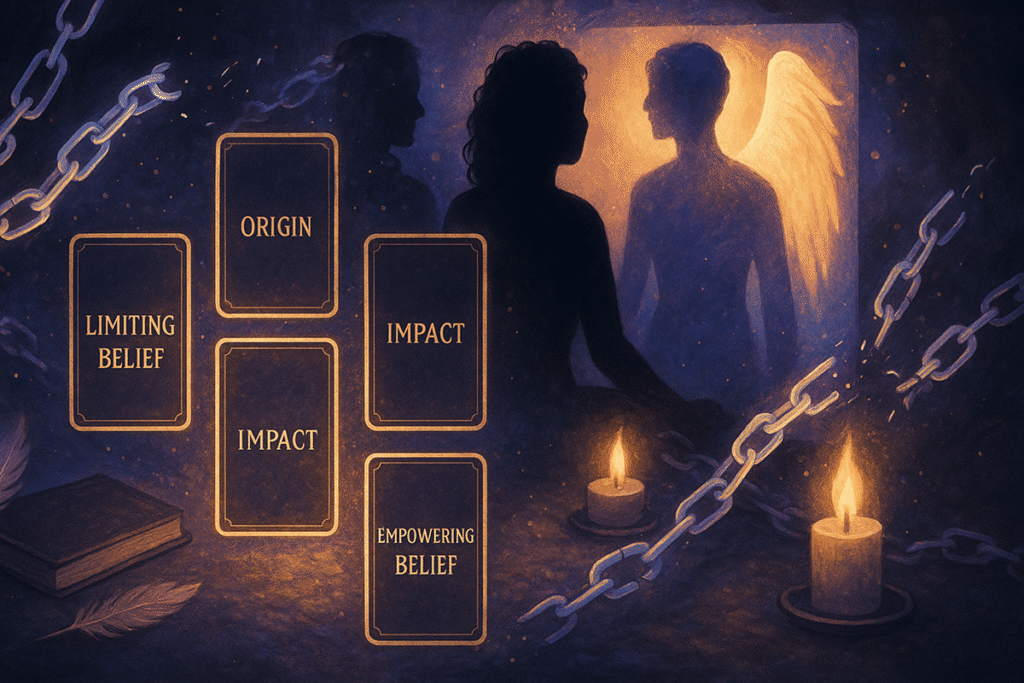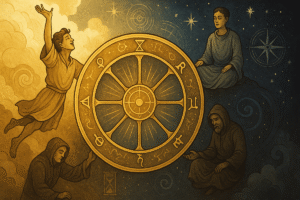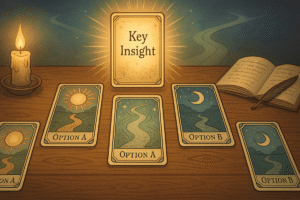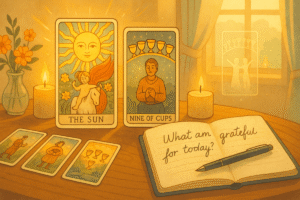Table of Contents
There’s something oddly persistent about the stories we tell ourselves. You know the ones. The quiet voice that says you’re not creative enough, or that success isn’t really meant for people like you. These narratives operate beneath the surface of conscious thought, shaping decisions and coloring experiences in ways we rarely pause to examine.
I’ve found that tarot offers a unique framework for bringing these hidden patterns into view. Not because the cards themselves hold supernatural knowledge, but because they create space for reflection. They interrupt our usual mental routines and invite us to consider questions we might otherwise avoid.
This spread is designed specifically for that purpose. It’s a tool for self-inquiry, a structured conversation with the parts of yourself that typically remain unexamined.
Understanding Limiting Beliefs Through Reflection
Before we explore the spread itself, it helps to clarify what we’re actually looking for. A limiting belief isn’t just a negative thought. It’s a deeply held assumption about yourself, others, or how the world works that restricts your possibilities. These beliefs often masquerade as facts rather than interpretations.
Perhaps you’ve noticed yourself saying things like “I’m just not good with money” or “I always mess up relationships.” These statements feel true because they’re reinforced by selective attention. We notice evidence that confirms them and overlook contradictions. The belief becomes self-fulfilling.
What makes these patterns particularly stubborn is their origin. Many limiting beliefs form during childhood or moments of vulnerability, when we lacked the perspective to question them. A careless comment from a teacher becomes internalized as “I’m not smart.” A parent’s anxiety about finances transforms into “there’s never enough.”
Tarot won’t magically dissolve these patterns, but it can help you see them more clearly. And seeing them clearly is, I think, the essential first step toward change.
The Five Card Spread Layout
This spread uses five positions, each addressing a different aspect of the limiting belief cycle. You’ll want to find a quiet space where you can focus without interruption. I usually recommend taking a few deep breaths before you begin, just to settle your mind and create a clear transition into reflective mode.
Shuffle your deck while holding the intention to explore what might be blocking you. When you feel ready, lay out five cards in a simple row from left to right. There’s no need for elaborate ceremony. The power here comes from your willingness to engage honestly with whatever emerges.
Take your time with each card. Let your initial impressions arise before consulting any guidebook meanings. Your intuitive response often carries insights that external interpretations might miss.
Position One: The Limiting Belief
The first card represents the limiting belief itself, though it may not reveal its nature immediately. This position asks you to identify the story that’s been running in the background of your thoughts.
When you look at this card, consider what it evokes emotionally. Does it bring up feelings of constriction, fear, or resignation? The imagery might point toward themes of isolation, defeat, or inadequacy. Or it might be more subtle, suggesting something about control, perfectionism, or the need for external validation.
I find it helpful to write down whatever comes to mind, even if it seems tangential at first. Sometimes the belief announces itself clearly. Other times, you’ll need to circle around it through free association until the core assumption reveals itself.
Let’s say you draw the Eight of Swords. The traditional imagery shows a bound figure surrounded by swords, seemingly trapped. Rather than concluding “this means I feel trapped,” sit with the image. Where in your life do you feel surrounded by obstacles? What beliefs about your own power or agency might be keeping you immobilized?
The question isn’t what the card predicts. It’s what the card helps you notice about your current internal landscape.
Position Two: The Origin Point
The second card invites exploration of where this belief might have taken root. This isn’t about assigning blame or excavating trauma. It’s simply about understanding context.
Limiting beliefs don’t appear from nowhere. They form in response to experiences, often as protective mechanisms that made sense at the time. A child who learns to stay quiet to avoid conflict might develop a belief that their voice doesn’t matter. Someone who experienced financial instability might internalize scarcity as a fundamental truth rather than a circumstantial reality.
When you examine this card, think about patterns from your past. Does it suggest family dynamics, early relationships, cultural messages, or specific events? The Four of Cups might point toward a time of emotional withdrawal or feeling overlooked. The Five of Pentacles could indicate experiences of lack or exclusion.
You’re not looking for a single definitive moment, necessarily. Sometimes beliefs accumulate through repeated smaller experiences rather than one dramatic incident. The goal is to recognize that this belief has a history. It was learned, which means it can be unlearned.
Position Three: How It Shapes Your Actions
The third position examines the practical impact of this belief on your behavior. This is where abstract thoughts become concrete consequences.
Limiting beliefs don’t just make you feel bad. They actively shape what you attempt, how you engage with opportunities, and the risks you’re willing to take. Someone who believes they’re inherently unlikeable might avoid social situations, thereby ensuring they never gather evidence to the contrary. Someone convinced they lack discipline might not even attempt the projects that interest them.
Look at the card in this position and ask yourself what actions you’ve avoided or what patterns keep repeating. The Two of Swords might suggest paralysis in decision making, an inability to commit that stems from fear of making the wrong choice. The Seven of Wands could indicate exhausting, defensive postures born from the belief that you’re always under attack.
Be specific here. Instead of “it makes me anxious,” try “it stops me from applying for jobs I’m qualified for” or “it keeps me saying yes when I want to say no.” The more concrete you can be about behavioral patterns, the more useful this reflection becomes.
Position Four: An Alternative Perspective
Now we arrive at perhaps the most important position. The fourth card suggests an empowering belief you might practice instead. Notice I said practice, not adopt or force yourself to believe.
You can’t simply decide to believe something different and expect decades of conditioning to evaporate. But you can begin practicing a new perspective, trying it on like a piece of clothing you’re not sure fits yet. Over time, with repeated practice, alternative beliefs can become just as natural as the limiting ones currently feel.
This card isn’t offering you toxic positivity or demanding you pretend everything is fine. It’s pointing toward a more expansive, more accurate understanding of your capabilities and circumstances.
The Strength card might suggest practicing the belief that you have inner resources you haven’t fully tapped. The Star could point toward trusting that healing and growth are possible, even when progress feels slow. The Ace of Wands might invite you to experiment with believing that your creative impulses are valid and worth pursuing.
Write down the alternative belief in simple, present tense language. Not “I will be confident” but “I have valuable contributions to make.” Not “I’ll be better with money” but “I can learn to manage resources effectively.”
Position Five: Your First Step Forward
The final card addresses implementation. Insight without action remains theoretical. This position asks what small, concrete step you might take to begin embodying your new belief.
The emphasis here should be on “small.” You’re not looking for a dramatic life overhaul. You’re looking for something manageable that you can actually do in the next few days. Sustainable change happens through accumulated small actions, not grand gestures that fizzle out.
If your new belief is about having a voice that matters, your first step might be sharing an opinion in a low stakes conversation. If it’s about creative validity, maybe you spend fifteen minutes sketching or writing without judgment. The Two of Pentacles might suggest balancing something new with existing commitments rather than trying to revolutionize everything at once.
The card may also indicate an attitude or approach rather than a specific action. The Hermit could suggest that your first step is simply spending time in quiet reflection, getting clear on your values before taking external action. The Six of Cups might point toward reconnecting with activities or people that remind you of your inherent worth.
Whatever emerges, commit to it. Write it down. Put it in your calendar. Tell someone about it. The gap between insight and transformation is bridged by consistent, intentional practice.
Working With What Emerges
After completing the spread, you’ll have a map of sorts. Not a prediction about your future, but a reflection of your current internal terrain and potential paths forward.
I think it’s worth revisiting this spread periodically. Limiting beliefs are stubborn, but they’re not permanent. As you practice new perspectives and take different actions, the landscape shifts. A spread you do six months from now might reveal entirely different patterns, or it might show you how far you’ve come with the ones you’re currently addressing.
Some people find it helpful to journal about the spread, exploring each position in writing. Others prefer to photograph the layout and return to it throughout the week, letting insights emerge gradually. There’s no correct method. The practice is whatever helps you engage most authentically with the questions being raised.
Remember that this work isn’t about achieving some perfect state of unshakeable confidence. It’s about developing awareness of the stories you’re telling yourself and consciously choosing whether those stories still serve you. That’s enough. That’s actually quite a lot.
Frequently Asked Questions
Can I use this spread if I’m new to tarot?
Yes, this five card spread is beginner friendly. You don’t need years of experience to work with it effectively. Start by noticing your initial emotional response to each card before consulting any guidebook meanings. Your intuition often provides the most relevant insights, especially when you’re reflecting on your own patterns and blocks.
How often should I repeat this spread for the same limiting belief?
Wait at least a few weeks before revisiting the same belief with this spread. Limiting beliefs shift gradually through consistent practice of new perspectives, not through repeated readings. If the same card appears multiple times when you do return to the question, it typically means you haven’t fully absorbed or implemented the message from your previous reading.
What if the card in position four doesn’t resonate as an empowering belief?
Not every card will immediately feel empowering, and that’s normal. Sit with it longer and explore what alternative interpretation might serve you. Sometimes challenging cards point toward uncomfortable truths we need to face before we can move forward. You can also pull a clarifying card to help understand how this perspective could support your growth.
Do I need to work on all five positions at once?
No, and trying to tackle everything simultaneously often leads to overwhelm. Focus primarily on positions four and five, your new belief and first step. The other positions provide context and understanding, but actual change happens through practicing the alternative perspective and taking concrete action. Revisit the full spread periodically to track your progress.







